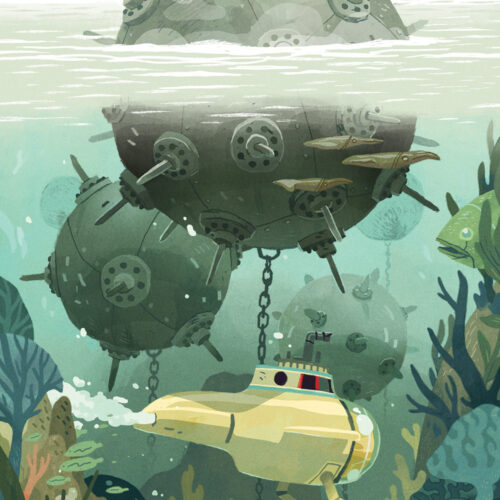Early on a Saturday morning 60 years ago, the millennia-old dream of spaceflight came true as Sputnik 1 rocketed into orbit to become Earth’s first human-made satellite. The mission notoriously shocked the world and minted a new era of human exploration, but what’s less well-known is that Sputnik arose, in part, from a 19th century dream to raise the dead. Really.
On this day in 1957, the 184-pound spacecraft departed from a modest Kazakh launchpad that would later evolve into the famous Baikonur Cosmodrome, currently the only spaceport on Earth capable of transporting humans to the International Space Station (ISS). The local time of liftoff was 1:28 AM on October 5, but for people living in North American, European, and Western Russian time zones, the launch occurred on Friday, October 4, and history has memorialized that date as Sputnik’s anniversary.
Sputnik triggered the Space Race, a geopolitically intense and technologically productive phase of the Cold War, which climaxed with NASA’s six Apollo Moon landings from 1969 to 1972. The Sputnik crisis, a period of Western anxietyabout the clear Soviet lead in spaceflight—and its reconnaissance and military implications—jumpstarted American defense, science, and education initiatives that profoundly impacted the course of world events over the subsequent six decades.
Look at this caption. Look.
This explains why the satellite’s flight is usually framed as the starting shot of a new era, syncing up with the “space race” metaphor. Sputnik is remembered for the world it made, not the world that made it. But the run-up to this mission is as fascinating as its fallout, and weaves together the stories of visionary thinkers against the tumultuous backdrop of imperial Russia’s transition into the communist USSR.
As a bonus, if you trace Sputnik’s origins back far enough, you get spacefaring zombies. It turns out that resurrecting dead people, and sending them to colonize alien planets, was a motivating factor in the development of Russian spaceflight. It began with the futurist philosopher Nikolai Fyodorov (often anglicized as “Fedorov”), who was born in 1829 in the Tambov province of imperial Russia.
Fyodorov believed that humanity needed to be liberated from death to achieve perfection, a view shaped by his Russian Orthodox Christian faith, especially its resurrection stories. Like other transhumanists who have envisioned immortality, Fyodorov speculated about ways to extend lifespans indefinitely, but he also took the premise a lot farther.
As a bonus, if you trace Sputnik’s origins back far enough, you get spacefaring zombies. It turns out that resurrecting dead people, and sending them to colonize alien planets, was a motivating factor in the development of Russian spaceflight. It began with the futurist philosopher Nikolai Fyodorov (often anglicized as “Fedorov”), who was born in 1829 in the Tambov province of imperial Russia.
Fyodorov believed that humanity needed to be liberated from death to achieve perfection, a view shaped by his Russian Orthodox Christian faith, especially its resurrection stories. Like other transhumanists who have envisioned immortality, Fyodorov speculated about ways to extend lifespans indefinitely, but he also took the premise a lot farther.

It wasn’t enough to prevent the death of every living person. Every dead person also had to be brought back to life so they could rejoin their descendents in a utopian future. He called this mission humanity’s “common task.”
In other words, Fyodorov believed that “humanity’s moral task was to emulate Christ and make bodily resurrection possible,” writes Asif Siddiqi, a space historian based at Fordham University, in his book The Red Rockets’ Glare. “Mass resurrection would finally eliminate the artificial boundaries among the ‘brotherhood’ of humanity, that is, between the previous and current generations.”
As a bonus, if you trace Sputnik’s origins back far enough, you get spacefaring zombies. It turns out that resurrecting dead people, and sending them to colonize alien planets, was a motivating factor in the development of Russian spaceflight. It began with the futurist philosopher Nikolai Fyodorov (often anglicized as “Fedorov”), who was born in 1829 in the Tambov province of imperial Russia.
Fyodorov believed that humanity needed to be liberated from death to achieve perfection, a view shaped by his Russian Orthodox Christian faith, especially its resurrection stories. Like other transhumanists who have envisioned immortality, Fyodorov speculated about ways to extend lifespans indefinitely, but he also took the premise a lot farther.
Recent posts
- Physicists Nail Down the ‘Magic Number’ That Shapes the Universe.The fine-structure constant was introduced in 1916 to quantify the tiny gap between two lines in the spectrum of colors emitted by certain atoms. The closely spaced frequencies are… Read more: Physicists Nail Down the ‘Magic Number’ That Shapes the Universe.
- How Dreams of Spacefaring Zombies Led to the Launch of Sputnik.Early on a Saturday morning 60 years ago, the millennia-old dream of spaceflight came true as Sputnik 1 rocketed into orbit to become Earth’s first human-made satellite. The mission… Read more: How Dreams of Spacefaring Zombies Led to the Launch of Sputnik.




